
Volume 24, No 7, Jul 2014
ISSN: 1001-0602
EISSN: 1748-7838 2018
impact factor 17.848*
(Clarivate Analytics, 2019)
Volume 24 Issue 7, July 2014: 809-819 | Open Access
ORIGINAL ARTICLES
An epigenomic approach to therapy for tamoxifen-resistant breast cancer
Qin Feng1, Zheng Zhang1, Martin J Shea2, Chad J Creighton3, Cristian Coarfa3, Susan G Hilsenbeck2, Rainer Lanz1, Bin He1,4, Lei Wang1, Xiaoyong Fu1,2,3, Agostina Nardone1,2,3, Yongcheng Song5, James Bradner6, Nicholas Mitsiades3,4, Constantine S Mitsiades6, C Kent Osborne1,2,3, Rachel Schiff1,2,3 and Bert W O Malley1,3
1Department of Molecular and Cellular Biology, Baylor College of Medicine, Houston, TX 77030, USA
2Lester & Sue Smith Breast Center, Baylor College of Medicine, Houston, TX 77030, USA
3Dan L. Duncan Cancer Center, Baylor College of Medicine, Houston, TX 77030, USA
4Department of Medicine-Hematology & Oncology, Baylor College of Medicine, Houston, TX 77030, USA
5Department of Pharmacology, Baylor College of Medicine, Houston, TX 77030, USA
6Department of Medical Oncology, Dana-Farber Cancer Institute, Department of Medicine, Harvard Medical School, Boston, MA 02215, USA
Correspondence: Bert W O Malley,(E-mail: berto@bcm.edu)
Tamoxifen has been a frontline treatment for estrogen receptor alpha (ERα)-positive breast tumors in premenopausal women. However, resistance to tamoxifen occurs in many patients. ER still plays a critical role in the growth of breast cancer cells with acquired tamoxifen resistance, suggesting that ERα remains a valid target for treatment of tamoxifen-resistant (Tam-R) breast cancer. In an effort to identify novel regulators of ERα signaling, through a small-scale siRNA screen against histone methyl modifiers, we found WHSC1, a histone H3K36 methyltransferase, as a positive regulator of ERα signaling in breast cancer cells. We demonstrated that WHSC1 is recruited to the ERα gene by the BET protein BRD3/4, and facilitates ERα gene expression. The small-molecule BET protein inhibitor JQ1 potently suppressed the classic ERα signaling pathway and the growth of Tam-R breast cancer cells in culture. Using a Tam-R breast cancer xenograft mouse model, we demonstrated in vivo anti-breast cancer activity by JQ1 and a strong long-lasting effect of combination therapy with JQ1 and the ER degrader fulvestrant. Taken together, we provide evidence that the epigenomic proteins BRD3/4 and WHSC1 are essential regulators of estrogen receptor signaling and are novel therapeutic targets for treatment of Tam-R breast cancer.
10.1038/cr.2014.71
FULL TEXT | PDF
Browse 2032


